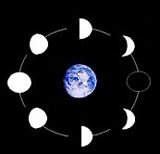Behaviour of the Moon
As the Earth orbits the Sun, the Moon orbits the Earth. It is the Earth's only natural satellite, orbiting once every 27.3 days at an average distance of 384,400km from the Earth. The Moon is about a quarter of the size of the Earth and its gravity is about 6 times weaker.
Ancient study
Being so visible in the night sky, the Moon has long been a source of fascination for humans. Even before modern science, the ancient philosophers of Babylon (modern Iraq) and Greece made significant discoveries about the behaviour of the Moon.
Aristotle (384-322 BC) and Pythagoras (580-500 BC) provided an explanation of the appearance of the Moon due to illumination by the Sun. Aristarchus (310-230 BC) first identified the relative sizes of the Earth and the Moon, and in 150 AD Ptolemy even measured the distance to the Moon.
The efforts of later astronomers such as Copernicus, Tycho, Kepler and Galileo more accurately defined the Moon's behaviour.
Phases

Phases of the Moon
As the Moon travels around the Earth, its appearance in the night sky changes. As the Moon does not emit any light of its own, we can only see it when it is reflecting the Sun's light.
Depending on the relative positions of the Moon and Sun, different amounts of the Moon will be visible from Earth. These changes in the appearance of the Moon are known as phases.
Occasionally the Moon passes between the Sun and Earth blocking out the Sun's light from Earth. When the Earth passes through the Moon's shadow like this it produces a solar eclipse. More frequently, however, the situation is reversed and it is the Moon that passes through the Earth's shadow producing a lunar eclipse.
Gravity
The mass of the Moon is about a hundred times smaller than the Earth. Although this may appear small, it is in fact relatively large for a natural satellite. Because of this relatively large mass, the Moon's gravity exerts enough force to move the oceans and create tides.
These tidal forces also make the Moon rotate on its axis once a day. This means that the same side of the Moon always faces the Earth and we never see the far side of the Moon.
Toolbox

The Museum's smallest members of staff are our flesh-eating beetles, Dermestes maculates, who strip carcasses to the bone.